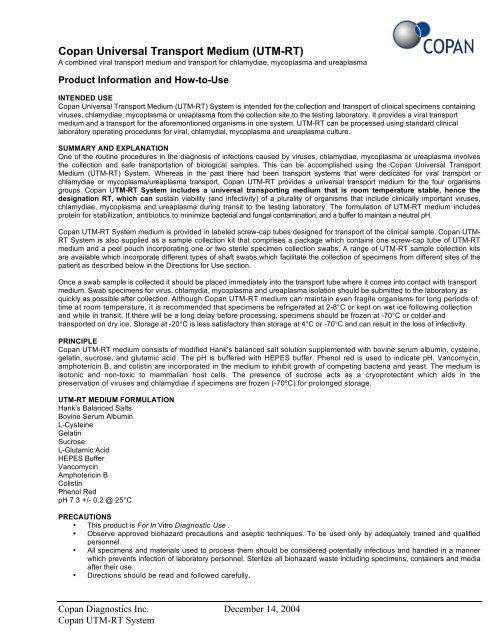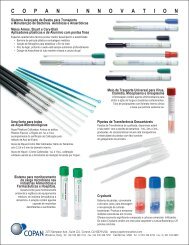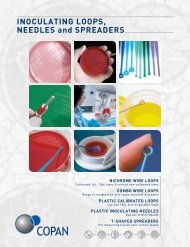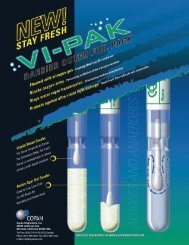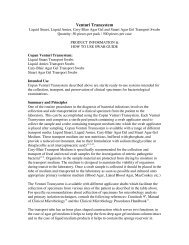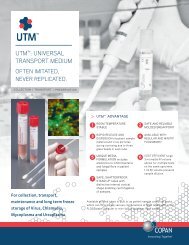Copan Universal Transport Medium (UTM-RT) - Copan Diagnostics
Copan Universal Transport Medium (UTM-RT) - Copan Diagnostics
Copan Universal Transport Medium (UTM-RT) - Copan Diagnostics
Create successful ePaper yourself
Turn your PDF publications into a flip-book with our unique Google optimized e-Paper software.
<strong>Copan</strong> <strong>Universal</strong> <strong>Transport</strong> <strong>Medium</strong> (<strong>UTM</strong>-<strong>RT</strong>)<br />
A combined viral transport medium and transport for chlamydiae, mycoplasma and ureaplasma<br />
Product Information and How-to-Use<br />
INTENDED USE<br />
<strong>Copan</strong> <strong>Universal</strong> <strong>Transport</strong> <strong>Medium</strong> (<strong>UTM</strong>-<strong>RT</strong>) System is intended for the collection and transport of clinical specimens containing<br />
viruses, chlamydiae, mycoplasma or ureaplasma from the collection site to the testing laboratory. It provides a viral transport<br />
medium and a transport for the aforemontioned organisms in one system. <strong>UTM</strong>-<strong>RT</strong> can be processed using standard clinical<br />
laboratory operating procedures for viral, chlamydial, mycoplasma and ureaplasma culture.<br />
SUMMARY AND EXPLANATION<br />
One of the routine procedures in the diagnosis of infections caused by viruses, chlamydiae, mycoplasma or ureaplasma involves<br />
the collection and safe transportation of biological samples. This can be accomplished using the <strong>Copan</strong> <strong>Universal</strong> <strong>Transport</strong><br />
<strong>Medium</strong> (<strong>UTM</strong>-<strong>RT</strong>) System. Whereas in the past there had been transport systems that were dedicated for viral transport or<br />
chlamydiae or mycoplasma/ureaplasma transport, <strong>Copan</strong> <strong>UTM</strong>-<strong>RT</strong> provides a universal transport medium for the four organisms<br />
groups. <strong>Copan</strong> <strong>UTM</strong>-<strong>RT</strong> System includes a universal transporting medium that is room temperature stable, hence the<br />
designation <strong>RT</strong>, which can sustain viability (and infectivity) of a plurality of organisms that include clinically important viruses,<br />
chlamydiae, mycoplasma and ureaplasma during transit to the testing laboratory. The formulation of <strong>UTM</strong>-<strong>RT</strong> medium includes<br />
protein for stabilization, antibiotics to minimize bacterial and fungal contamination, and a buffer to maintain a neutral pH.<br />
<strong>Copan</strong> <strong>UTM</strong>-<strong>RT</strong> System medium is provided in labeled screw-cap tubes designed for transport of the clinical sample. <strong>Copan</strong> <strong>UTM</strong>-<br />
<strong>RT</strong> System is also supplied as a sample collection kit that comprises a package which contains one screw-cap tube of <strong>UTM</strong>-<strong>RT</strong><br />
medium and a peel pouch incorporating one or two sterile specimen collection swabs. A range of <strong>UTM</strong>-<strong>RT</strong> sample collection kits<br />
are available which incorporate different types of shaft swabs which facilitate the collection of specimens from different sites of the<br />
patient as described below in the Directions for Use section.<br />
Once a swab sample is collected it should be placed immediately into the transport tube where it comes into contact with transport<br />
medium. Swab specimens for virus, chlamydia, mycoplasma and ureaplasma isolation should be submitted to the laboratory as<br />
quickly as possible after collection. Although <strong>Copan</strong> <strong>UTM</strong>-<strong>RT</strong> medium can maintain even fragile organisms for long periods of<br />
time at room temperature, it is recommended that specimens be refrigerated at 2-8°C or kept on wet ice following collection<br />
and while in transit. If there will be a long delay before processing, specimens should be frozen at -70°C or colder and<br />
transported on dry ice. Storage at -20°C is less satisfactory than storage at 4°C or -70°C and can result in the loss of infectivity.<br />
PRINCIPLE<br />
<strong>Copan</strong> <strong>UTM</strong>-<strong>RT</strong> medium consists of modified Hank's balanced salt solution supplemented with bovine serum albumin, cysteine,<br />
gelatin, sucrose, and glutamic acid. The pH is buffered with HEPES buffer. Phenol red is used to indicate pH. Vancomycin,<br />
amphotericin B, and colistin are incorporated in the medium to inhibit growth of competing bacteria and yeast. The medium is<br />
isotonic and non-toxic to mammalian host cells. The presence of sucrose acts as a cryoprotectant which aids in the<br />
preservation of viruses and chlamydiae if specimens are frozen (-70ºC) for prolonged storage.<br />
<strong>UTM</strong>-<strong>RT</strong> MEDIUM FORMULATION<br />
Hank’s Balanced Salts<br />
Bovine Serum Albumin<br />
L-Cysteine<br />
Gelatin<br />
Sucrose<br />
L-Glutamic Acid<br />
HEPES Buffer<br />
Vancomycin<br />
Amphotericin B<br />
Colistin<br />
Phenol Red<br />
pH 7.3 +/- 0.2 @ 25°C<br />
PRECAUTIONS<br />
• This product is For In Vitro Diagnostic Use .<br />
• Observe approved biohazard precautions and aseptic techniques. To be used only by adequately trained and qualified<br />
personnel.<br />
• All specimens and materials used to process them should be considered potentially infectious and handled in a manner<br />
which prevents infection of laboratory personnel. Sterilize all biohazard waste including specimens, containers and media<br />
after their use.<br />
• Directions should be read and followed carefully.<br />
<strong>Copan</strong> <strong>Diagnostics</strong> Inc. December 14, 2004<br />
<strong>Copan</strong> <strong>UTM</strong>-<strong>RT</strong> System
STORAGE<br />
This product is ready for use and no further preparation is necessary. The product should be stored in its original container at<br />
2-25°C until used. Do not overheat. Do not incubate, or freeze prior to use. Improper storage will result in a loss of efficacy.<br />
Do not use after expiration date, which is clearly printed on the outer box and on each individual sterile pouch unit and the<br />
specimen transport tube label.<br />
PRODUCT DETERIORATION<br />
<strong>Copan</strong> <strong>UTM</strong>-<strong>RT</strong> should not be used if (1) there is evidence of damage or contamination to the product, (2) there is evidence of<br />
leakage, (3) the color of the medium has changed from light orange-red, (4) the expiration date has passed, (5) the swab pouch is<br />
open, or (6) there are other signs of deterioration.<br />
SPECIMEN COLLECTION, STORAGE AND TRANSPO<strong>RT</strong>ATION<br />
Specimens for virus, chlamydia, mycoplasma or ureaplasma investigation should be collected and handled following published<br />
manuals and guidelines. 2,3,4,7,9,10,11 To maintain optimum viability, transport the specimen to the laboratory as soon as possible.<br />
Best recovery is obtained when specimens are refrigerated at 2-8°C or kept on wet ice following collection and while in<br />
transit. If there will be a long delay before processing, specimens should be frozen at -70°C or colder and transported on dry ice.<br />
Specific requirements for the shipment and handling of specimens should be in full compliance with state and federal<br />
regulations 8,11,12 . Shipping of specimens within medical institutions should comply with internal guidelines of the institution. All<br />
specimens should be processed as soon as they are received in the laboratory.<br />
MATERIALS SUPPLIED<br />
<strong>Copan</strong> <strong>UTM</strong>-<strong>RT</strong> System includes a screw-cap tube containing 1.5ml, 3ml or 10ml of transport medium plus three 3mm size glass<br />
beads. <strong>UTM</strong>-<strong>RT</strong> System tubes of transport medium are supplied alone or in a kit format with one of the following six specimen<br />
collection swab options:<br />
One regular size plastic shaft swab with polyester fiber tip<br />
Two regular size plastic shaft swabs with polyester fiber tips<br />
One regular size plastic shaft swab and one Minitip plastic shaft swab pre-scored for easy breakage, both with polyester fiber tips<br />
One Minitip plastic shaft swab with polyester fiber tip pre-scored for easy breakage<br />
One Combo stainless steel wire-plastic shaft Minitip swab with polyester fiber tip<br />
One regular size plastic shaft swab and one Combo stainless steel wire-plastic shaft Minitip swab, both with polyester fiber tips<br />
These different swab applicator shafts facilitate the collection of specimens from various sites on a patient.<br />
Refer to the individual product descriptions for specific information about materials supplied.<br />
MATERIALS REQUIRED BUT NOT SUPPLIED<br />
Appropriate materials for isolating, differentiating and culturing viruses, chlamydiae, mycoplasma and ureaplasma. These<br />
materials include tissue culture cell lines, tissue culture medium, incubation systems and reading equipment. Refer to appropriate<br />
references for recommended protocols for isolation and identification of viruses, chlamydiae, mycoplasma and ureaplasma<br />
agents. 2,3,4,7,10<br />
DIRECTIONS FOR USE<br />
<strong>Copan</strong> <strong>UTM</strong>-<strong>RT</strong> System is available in the product configurations indicated in the table below.<br />
Catalog<br />
No. <strong>UTM</strong>-<strong>RT</strong> <strong>Medium</strong> Tubes Description<br />
330C 3ml of <strong>UTM</strong>-<strong>RT</strong> medium in 16x100 mm size screw-cap tube with internal<br />
shaped conical bottom. Each tube contains three 3mm glass beads.<br />
331C 10ml of <strong>UTM</strong>-<strong>RT</strong> medium in 30ml size screw-cap tube with internal shaped<br />
conical bottom. Each tube contains three 3mm glass beads.<br />
Catalog<br />
<strong>UTM</strong>-<strong>RT</strong> Collection Kit Description<br />
No. TUBE SWAB<br />
302C 3ml of <strong>UTM</strong>-<strong>RT</strong> medium in 16x100 two sterile wrapped regular size<br />
mm size screw-cap tube with internal plastic shaft polyester applicator<br />
shaped conical bottom. Each tube<br />
contains three 3mm glass beads.<br />
swabs<br />
<strong>Copan</strong> <strong>Diagnostics</strong> Inc. December 14, 2004<br />
<strong>Copan</strong> <strong>UTM</strong>-<strong>RT</strong> System<br />
Pack<br />
Size Sampling Sites*<br />
5 x 50 Vesicle aspirates,<br />
tubes corneal or conjunctival<br />
scrapings, small<br />
pieces of tissue or<br />
stool samples<br />
5 x 50 Vesicle aspirates,<br />
tubes corneal or conjunctival<br />
scrapings, small<br />
pieces of tissue or<br />
stool samples<br />
Pack<br />
Size Sampling Sites*<br />
6 x 50 kits Throat, cervical,<br />
vulvar, rectal and<br />
nasal, dermal,<br />
mucosal, and genital<br />
lesions
303C 3ml of <strong>UTM</strong>-<strong>RT</strong> medium in 16x100<br />
mm size screw-cap tube with internal<br />
shaped conical bottom. Each tube<br />
contains three 3mm glass beads.<br />
328C 3ml of <strong>UTM</strong>-<strong>RT</strong> medium in 16x100<br />
mm size screw-cap tube with internal<br />
shaped conical bottom. Each tube<br />
contains three 3mm glass beads.<br />
329C 3ml of <strong>UTM</strong>-<strong>RT</strong> medium in 16x100<br />
mm size screw-cap tube with internal<br />
shaped conical bottom. Each tube<br />
contains three 3mm glass beads.<br />
339C 3ml of <strong>UTM</strong>-<strong>RT</strong> medium in 16x100<br />
mm size screw-cap tube with internal<br />
shaped conical bottom. Each tube<br />
contains three 3mm glass beads.<br />
340C 3ml of <strong>UTM</strong>-<strong>RT</strong> medium in 16x100<br />
mm size screw-cap tube with internal<br />
shaped conical bottom. Each tube<br />
contains three 3mm glass beads.<br />
343C 1.5ml of <strong>UTM</strong>-<strong>RT</strong> medium in 16x100<br />
mm size screw-cap tube with internal<br />
shaped conical bottom. Each tube<br />
contains three 3mm glass beads.<br />
305C 3ml of <strong>UTM</strong>-<strong>RT</strong> medium in 16x100<br />
mm size screw-cap tube with internal<br />
shaped conical bottom. Each tube<br />
contains three 3mm glass beads.<br />
306C 3ml of <strong>UTM</strong>-<strong>RT</strong> medium in 16x100<br />
mm size screw-cap tube with internal<br />
shaped conical bottom. Each tube<br />
contains three 3mm glass beads.<br />
307C 3ml of <strong>UTM</strong>-<strong>RT</strong> medium in 16x100<br />
mm size screw-cap tube with internal<br />
shaped conical bottom. Each tube<br />
contains three 3mm glass beads.<br />
359C 1ml of <strong>UTM</strong>-<strong>RT</strong> medium in 12x80 mm<br />
size screw-cap tube with internal<br />
shaped conical bottom. Each tube<br />
contains three 3mm glass beads.<br />
360C 1ml of <strong>UTM</strong>-<strong>RT</strong> medium in 12x80 mm<br />
size screw-cap tube with internal<br />
shaped conical bottom. Each tube<br />
contains three 3mm glass beads.<br />
361C 1ml of <strong>UTM</strong>-<strong>RT</strong> medium in 12x80 mm<br />
size screw-cap tube with internal<br />
shaped conical bottom. Each tube<br />
contains three 3mm glass beads.<br />
one sterile wrapped regular size<br />
plastic shaft polyester applicator<br />
swab and one Minitip plastic shaft<br />
polyester applicator swab pre-scored<br />
for easy breakage<br />
one sterile wrapped regular size<br />
plastic shaft polyester applicator swab<br />
one sterile wrapped Minitip plastic<br />
shaft polyester applicator swab prescored<br />
for easy breakage<br />
one sterile wrapped Combo wire –<br />
plastic shaft Minitip polyester<br />
applicator swab<br />
one sterile wrapped regular size<br />
plastic shaft polyester applicator swab<br />
and one Combo wire – plastic shaft<br />
Minitip polyester applicator swab<br />
two sterile wrapped regular size<br />
plastic shaft polyester applicator<br />
swabs<br />
one sterile wrapped plastic shaft<br />
Flexible Minitip flocked swab<br />
one sterile wrapped regular size<br />
plastic shaft flocked swab<br />
one sterile wrapped plastic shaft<br />
Minitip flocked swab<br />
one sterile wrapped regular size<br />
plastic shaft flocked swabs<br />
one sterile wrapped plastic shaft<br />
Flexible Minitip flocked swab<br />
one sterile wrapped plastic shaft<br />
Minitip flocked swab<br />
<strong>Copan</strong> <strong>Diagnostics</strong> Inc. December 14, 2004<br />
<strong>Copan</strong> <strong>UTM</strong>-<strong>RT</strong> System<br />
6 x 50 kits Throat, cervical,<br />
vulvar, rectal and<br />
nasal, dermal,<br />
mucosal, and genital<br />
lesions;<br />
eye/conjunctival,<br />
nasopharyngeal,<br />
urethral<br />
6 x 50 kits Throat, cervical,<br />
vulvar, rectal and<br />
nasal, dermal,<br />
mucosal, and genital<br />
lesions<br />
6 x 50 kits Eye/conjunctival,<br />
nasopharyngeal,<br />
urethral<br />
6 x 50 kits Eye/conjunctival,<br />
nasopharyngeal,<br />
urethral<br />
6 x 50 kits Throat, cervical,<br />
vulvar, rectal and<br />
nasal, dermal,<br />
mucosal, and genital<br />
lesions;<br />
eye/conjunctival,<br />
nasopharyngeal,<br />
urethral<br />
6 x 50 kits Throat, cervical,<br />
vulvar, rectal and<br />
nasal, dermal,<br />
mucosal, and genital<br />
lesions<br />
6 x 50 kits Eye/conjunctival,<br />
nasopharyngeal<br />
6 x 50 kits Throat, cervical,<br />
vulvar, rectal and<br />
nasal, dermal,<br />
mucosal, and genital<br />
lesions<br />
6 x 50 kits Eye/conjunctival,<br />
nasopharyngeal,<br />
urethral<br />
6 x 50 kits Throat, cervical,<br />
vulvar, rectal and<br />
nasal, dermal,<br />
mucosal, and genital<br />
lesions<br />
6 x 50 kits Eye/conjunctival,<br />
nasopharyngeal<br />
6 x 50 kits Eye/conjunctival,<br />
nasopharyngeal,<br />
urethral<br />
*Performance testing with <strong>Copan</strong> <strong>UTM</strong>-<strong>RT</strong> System was conducted using laboratory strains spiked onto a swab and not using<br />
human specimens.<br />
<strong>UTM</strong>-<strong>RT</strong> is available with other combinations of flocked swabs and polyester swabs.<br />
Proper specimen collection from the patient is extremely critical for successful isolation and identification of infectious<br />
organisms. For specific guidance regarding specimen collection procedures, consult published reference manuals. 1,2,3,4,7,9,10,11
Specimens should be collected as soon as possible after the clinical onset of disease. Highest viral titers are present during the<br />
acute illness.<br />
For <strong>UTM</strong>-<strong>RT</strong> <strong>Medium</strong> Tubes<br />
1. Aseptically remove cap from tube<br />
2. Aseptically place vesicle aspirates, corneal or conjunctival scrapings, small pieces of tissue or stool samples into the tube with<br />
<strong>UTM</strong>-<strong>RT</strong> medium<br />
3. Replace cap to tube and close tightly<br />
4. Label with appropriate patient information<br />
5. Send to the laboratory for immediate analysis<br />
For <strong>UTM</strong>-<strong>RT</strong> Collection Kits<br />
1. Collect specimen with swab 5. Replace cap to tube and close tightly<br />
2. Aseptically remove cap from tube 6 Label with appropriate patient information<br />
3. Insert swab into the tube with <strong>UTM</strong>-<strong>RT</strong> medium 7. Send to the laboratory for immediate analysis<br />
4. Break swab shaft by bending it against the tube wall. For<br />
Minitip swabs, break shaft evenly at the pre-scored line.<br />
QUALITY CONTROL<br />
All lot numbers of the <strong>UTM</strong>-<strong>RT</strong> medium are tested for microbial contamination, toxicity to host cells and the ability to maintain<br />
viability of desired agents. Procedures for quality control of <strong>UTM</strong>-<strong>RT</strong> transport medium and virus culture media are described in a<br />
number of publications by the American Society for Microbiology 3,7,10 and by NCCLS 5,6 . If aberrant quality control results are noted,<br />
patient results should not be reported.<br />
LIMITATIONS<br />
1. Specimens should be handled aseptically.<br />
2. Condition, timing, and volume of specimen collected for culture are significant variables in obtaining reliable culture results.<br />
Follow recommended guidelines for specimen collection. 1,2,3,4,7,10<br />
3. Repeated freezing and thawing of specimens may reduce the recovery of viable organisms.<br />
4. <strong>UTM</strong>-<strong>RT</strong> is intended for use as a collection and transport medium for viral, chlamydial, mycoplasma and ureaplasma agents<br />
only. This medium can serve as a cryoprotectant for clinical viruses, including Cytomegalovirus and Varicella Zoster Virus.<br />
5. Because calcium alginate swabs are toxic for many enveloped viruses and may interfere with fluorescent antibody tests, they<br />
should not be used for specimen collection. Wooden shaft swabs may contain toxins and formaldehydes and should not be<br />
used. Polyester (Dacron) tipped swabs and Flocked Swabs are suitable when specimen collection by a swab is appropriate.<br />
6. <strong>UTM</strong>-<strong>RT</strong> kits are intended to be used with the medium tubes and swabs provided in the kit. The use of tubes of medium or swabs from<br />
any other source could affect the performance of the product.<br />
WARNINGS<br />
• Do not re-sterilize unused swabs.<br />
• Do not re-pack<br />
• Not suitable to collect and transport microorganisms other than viruses, chlamydiae, mycoplasma and ureaplasma<br />
• Not suitable for any other application than intended use<br />
• The use of this product in association with a rapid diagnostic kit or with diagnostic instrumentation should be previously<br />
validated by the user<br />
• Do not use if the swab is visibly damaged (i.e., if the swab tip is broken)<br />
• Applicator swab is qualified as Class IIa Medical Device according to European Medical Device Directive 93/42/EEC -<br />
Surgically Invasive Transient Use<br />
Class IIa means swabs can be used for sampling body surfaces, body orifices (e.g., nose, throat and vagina and deep invasive<br />
surgical wounds)<br />
• Do not ingest the medium<br />
• To be handled by trained personnel only<br />
• Do not use the <strong>UTM</strong>-<strong>RT</strong> medium for premoistening or prewetting the applicator swab prior to collecting the sample or for rinsing<br />
or irrigating the sampling sites<br />
RESULTS<br />
Results obtained will largely depend on proper and adequate specimen collection, as well as timely transport and processing in the<br />
laboratory.<br />
PERFORMANCE CHARACTERISTICS<br />
Viability studies were performed using <strong>Copan</strong> <strong>UTM</strong>-<strong>RT</strong> with a variety of viruses, chlamydiae, mycoplasma and ureaplasma. Swabs<br />
accompanying each transport system were directly inoculated in triplicate with 100µl of organismsm suspension. Swabs were then<br />
placed in their respective transport medium tubes and were held for 0, 24 and 48 hours at both 4°C and room temperature (20-<br />
25°C). At the appropriate time interval, each swab was vortexed, removed from its transport medium tube and then an aliquot of<br />
this suspension was inoculated into shell vials or into appropriate culture media. All cultures were processed by standard laboratory<br />
culture technique and examined after a specified incubation time. Organism viability was determined by fluorescing foci counts for<br />
viruses and chlamydia strains and by CFU counts for mycoplasma and ureaplasma strains.<br />
<strong>Copan</strong> <strong>Diagnostics</strong> Inc. December 14, 2004<br />
<strong>Copan</strong> <strong>UTM</strong>-<strong>RT</strong> System
Organisms evaluated were: Adenovirus, Cytomegalovirus, Echovirus Type 30, Herpes Simplex Virus Type 1, Herpes Simplex Virus<br />
Type 2, Influenza A, Parainfluenza 3, Respiratory Syncytial Virus, Varicella Zoster Virus, Chlamydia pneumoniae, Chlamydia<br />
trachomatis, Mycoplasma hominis, Mycoplasma pneumoniae and Ureaplasma urealyticum.<br />
The results for the strains tested using <strong>Copan</strong> <strong>UTM</strong>-<strong>RT</strong> System are shown in the table below.<br />
<strong>Copan</strong> <strong>UTM</strong>-<strong>RT</strong> System was able to maintain the viability of the following organisms for at least 48 hours at both room<br />
temperature (20-25ºC) and in the refrigerator (2-8ºC) under the test conditions described above: Adenovirus,<br />
Cytomegalovirus, Echovirus Type 30, Herpes Simplex Virus Type 1, Herpes Simplex Virus Type 2, Influenza A,<br />
Parainfluenza 3, Respiratory Syncytial Virus, Varicella Zoster Virus, Chlamydia pneumoniae, Chlamydia trachomatis,<br />
Mycoplasma hominis, Mycoplasma pneumoniae and Ureaplasma urealyticum.<br />
Organism<br />
Adenovirus<br />
Cytomegalovirus<br />
Echovirus Type 30<br />
Herpes Simplex<br />
Virus Type 1<br />
Herpes Simplex<br />
Virus Type 2<br />
Influenza A<br />
Parainfluenza 3<br />
Respiratory<br />
Syncytial Virus<br />
Varicella Zoster<br />
Virus<br />
Organism Concentration<br />
10 -1 Neat Virus Stock Suspension*<br />
(dilution produces infectivity of 70% of cells)<br />
10 -2 Neat Virus Stock Suspension*<br />
(dilution produces infectivity of 42% of cells)<br />
Neat Virus Stock Suspension*<br />
(neat produces infectivity of 3% of cells)<br />
1:2 Neat Virus Stock Suspension*<br />
(dilution produces infectivity of 2% of cells)<br />
10 -1 Neat Virus Stock Suspension*<br />
(dilution produces infectivity of 64% of cells)<br />
10 -2 Neat Virus Stock Suspension*<br />
(dilution produces infectivity of 35% of cells)<br />
10 -1 Neat Virus Stock Suspension*<br />
(dilution produces infectivity of 100% of cells)<br />
10 -2 Neat Virus Stock Suspension*<br />
(dilution produces infectivity of 100% of cells)<br />
10 -1 Neat Virus Stock Suspension*<br />
(dilution produces infectivity of 90% of cells)<br />
10 -2 Neat Virus Stock Suspension*<br />
(dilution produces infectivity of 40% of cells)<br />
Neat Virus Stock Suspension*<br />
(neat produces infectivity of 59% of cells)<br />
10 -1 Neat Virus Stock Suspension*<br />
(dilution produces infectivity of 47% of cells)<br />
Neat Virus Stock Suspension*<br />
(neat produces infectivity of 57% of cells)<br />
10 -1 Neat Virus Stock Suspension*<br />
(dilution produces infectivity of 51% of cells)<br />
Neat Virus Stock Suspension*<br />
(neat produces infectivity of 47% of cells)<br />
10 -1 Neat Virus Stock Suspension*<br />
(dilution produces infectivity of 8% of cells)<br />
Neat Virus Stock Suspension*<br />
(neat produces infectivity of 8% of cells)<br />
1:2 Neat Virus Stock Suspension*<br />
(dilution produces infectivity of 2% of cells)<br />
Holding<br />
Time<br />
(hours)<br />
0<br />
24<br />
48<br />
0<br />
24<br />
48<br />
0<br />
24<br />
48<br />
0<br />
24<br />
48<br />
0<br />
24<br />
48<br />
0<br />
24<br />
48<br />
<strong>Copan</strong> <strong>Diagnostics</strong> Inc. December 14, 2004<br />
<strong>Copan</strong> <strong>UTM</strong>-<strong>RT</strong> System<br />
0<br />
24<br />
48<br />
0<br />
24<br />
48<br />
0<br />
24<br />
48<br />
0<br />
24<br />
48<br />
0<br />
24<br />
48<br />
0<br />
24<br />
48<br />
0<br />
24<br />
48<br />
0<br />
24<br />
48<br />
0<br />
24<br />
48<br />
0<br />
24<br />
48<br />
0<br />
24<br />
48<br />
0<br />
24<br />
48<br />
Incubation<br />
Time Before<br />
Reading<br />
(hours)<br />
24<br />
24<br />
24<br />
24<br />
24<br />
24<br />
24<br />
24<br />
24<br />
24<br />
24<br />
24<br />
24<br />
24<br />
24<br />
24<br />
24<br />
24<br />
24<br />
24<br />
24<br />
24<br />
24<br />
24<br />
24<br />
24<br />
24<br />
24<br />
24<br />
24<br />
16<br />
16<br />
16<br />
16<br />
16<br />
16<br />
24<br />
24<br />
24<br />
24<br />
24<br />
24<br />
24<br />
24<br />
24<br />
24<br />
24<br />
24<br />
72<br />
72<br />
72<br />
72<br />
72<br />
72<br />
Viability Challenge<br />
at 4°C<br />
Foci of infected<br />
cells/200 µl 2<br />
123<br />
62<br />
68<br />
17<br />
5<br />
5<br />
337<br />
582<br />
394<br />
49<br />
63<br />
72<br />
76<br />
59<br />
66<br />
34<br />
18<br />
25<br />
491<br />
387<br />
282<br />
98<br />
68<br />
21<br />
TNTC 1<br />
615<br />
525<br />
228<br />
170<br />
75<br />
129<br />
172<br />
166<br />
123<br />
71<br />
67<br />
24<br />
26<br />
26<br />
2<br />
12<br />
8<br />
178<br />
251<br />
183<br />
17<br />
28<br />
14<br />
TNTC 1<br />
TNTC 1<br />
283<br />
TNTC 1<br />
TNTC 1<br />
132<br />
Viability Challenge<br />
at <strong>RT</strong><br />
Foci of infected<br />
cells/200 µl 2<br />
119<br />
47<br />
63<br />
14<br />
3<br />
7<br />
444<br />
1012<br />
506<br />
195<br />
80<br />
228<br />
79<br />
75<br />
60<br />
48<br />
26<br />
20<br />
412<br />
301<br />
164<br />
100<br />
10<br />
1<br />
TNTC 1<br />
437<br />
58<br />
315<br />
73<br />
7<br />
134<br />
166<br />
169<br />
115<br />
72<br />
65<br />
32<br />
28<br />
19<br />
8<br />
10<br />
4<br />
248<br />
208<br />
232<br />
13<br />
21<br />
16<br />
TNTC 1<br />
TNTC 1<br />
424<br />
TNTC 1<br />
TNTC 1<br />
159
Organism<br />
Organism Concentration<br />
Neat Chlamydia Stock Suspension*<br />
(neat produces TNTC1 cytoplasmic inclusions over<br />
Chlamydia<br />
entire HeLa DHI shell vials coverslip)<br />
pneumoniae 10-1 Neat Chlamydia Stock Suspension*<br />
(dilution produces TNTC1 cytoplasmic inclusions<br />
over entire HeLa DHI shell vials coverslip)<br />
Neat Chlamydia Stock Suspension*<br />
(neat produces TNTC1 cytoplasmic inclusions<br />
Chlamydia over entire BGMK DHI shell vials coverslip)<br />
trachomatis 10-1 Neat Chlamydia Stock Suspension*<br />
(dilution produces TNTC1 cytoplasmic inclusions<br />
over entire BGMK DHI shell vials coverslip)<br />
Organism<br />
Mycoplasma<br />
hominis<br />
Mycoplasma<br />
pneumoniae<br />
Ureaplasma<br />
urealyticum<br />
Organism Concentration<br />
Neat Mycoplasma Stock Suspension*:<br />
Four Mycoplasma hominis Bacti disks<br />
reconstituted into 20ml of PPLO broth and<br />
incubated in 5-10% CO2 at 35°C - 37°C for 48<br />
hours (reference Remel Mycoplasma Bacti Disk<br />
Pack Insert TI No. 19314)<br />
10 -2 Neat Mycoplasma Stock Suspension*<br />
Neat Mycoplasma Stock Suspension*:<br />
Four Mycoplasma pneumoniae Bacti disks<br />
reconstituted into 20ml of SP4 broth with glucose<br />
and incubated in ambient air at 35°C - 37°C for 7-<br />
14 days until broth becomes yellow<br />
(reference Remel Mycoplasma Bacti Disk Pack<br />
Insert TI No. 19314)<br />
10 -1 Neat Mycoplasma Stock Suspension*<br />
Neat Ureaplasma Stock Suspension*:<br />
Ten Ureaplasma urealyticum Bacti disks<br />
reconstituted into 18ml of 10B broth and<br />
incubated in ambient air 35°C - 37°C for 24 hours<br />
(reference Remel Ureaplasma Bacti Disk Pack<br />
Insert TI No. 19315)<br />
10 -1 Neat Ureaplasma Stock Suspension*<br />
Holding<br />
Time<br />
(hours)<br />
0<br />
24<br />
48<br />
<strong>Copan</strong> <strong>Diagnostics</strong> Inc. December 14, 2004<br />
<strong>Copan</strong> <strong>UTM</strong>-<strong>RT</strong> System<br />
0<br />
24<br />
48<br />
0<br />
24<br />
48<br />
0<br />
24<br />
48<br />
Holding<br />
Time<br />
(hours)<br />
0<br />
24<br />
48<br />
0<br />
24<br />
48<br />
0<br />
24<br />
48<br />
0<br />
24<br />
48<br />
0<br />
24<br />
48<br />
0<br />
24<br />
48<br />
Incubation<br />
Time Before<br />
Reading<br />
(days)<br />
3<br />
3<br />
3<br />
3<br />
3<br />
3<br />
3<br />
3<br />
3<br />
3<br />
3<br />
3<br />
Incubation<br />
Time Before<br />
Reading<br />
(days)<br />
7<br />
7<br />
7<br />
7<br />
7<br />
7<br />
7<br />
7<br />
7<br />
7<br />
7<br />
7<br />
3<br />
3<br />
3<br />
Viability Challenge<br />
at 4°C<br />
Fluorescing cytoplasmic<br />
inclusions/200 µl 2<br />
TNTC 1<br />
TNTC 1<br />
201<br />
256<br />
175<br />
39<br />
TNTC 1<br />
TNTC 1<br />
317<br />
216<br />
164<br />
67<br />
Viability Challenge<br />
at 4°C<br />
CFU/200 µl 2<br />
~ 1000, TNTC 1<br />
~ 1000, TNTC 1<br />
~ 1000, TNTC 1<br />
17<br />
17<br />
11<br />
171<br />
219<br />
183<br />
17<br />
22<br />
17<br />
1020<br />
1136<br />
1249<br />
Viability Challenge<br />
at <strong>RT</strong><br />
Fluorescing cytoplasmic<br />
inclusions/200 µl 2<br />
TNTC 1<br />
TNTC 1<br />
136<br />
257<br />
276<br />
17<br />
TNTC 1<br />
TNTC 1<br />
50<br />
171<br />
48<br />
6<br />
Viability Challenge at<br />
<strong>RT</strong><br />
CFU/200 µl 2<br />
~ 1000, TNTC 1<br />
~ 1000, TNTC 1<br />
~ 1000, TNTC 1<br />
* 100 µl of suspension dosed onto the swab tip then swab placed in <strong>UTM</strong>-<strong>RT</strong> tube containing 3ml of transport medium<br />
1 TNTC= Too numerous to count<br />
2 Average of triplicate tests performed on 200 µl aliquots of <strong>UTM</strong>-<strong>RT</strong> medium at each time point<br />
BIBLIOGRAPHY<br />
1. Koneman, E.W., S.D. Allen, W.M. Janda, P.C. Schreckenberger and W.C. Winn, Jr. 1992. Color Atlas and Textbook of<br />
Diagnostic Microbiology. 4th ed. J.B. Lippincott Co. Philadelphia, PA.<br />
2. Murray, P.R., E.J. Baron, M.A. Pfaller, F.C. Tenover, and R.H. Yolken. 1999. Manual of Clinical Microbiology. 7th ed. ASM,<br />
Washington, D.C.<br />
3. Gleaves, C.A., R.L. Hodinka, S.L.G. Johnston, and E.M. Swierkosz. 1994. Cumitech 15A. Laboratory Diagnosis of Viral<br />
Infections. ASM, Washington, DC.<br />
4. Forbes, B.A., D.F. Sahm, and A.S Weissfeld. 1998. Bailey and Scott's Diagnostic Microbiology. 10th ed. Mosby, St. Louis, MO.<br />
5. National Committee for Clinical Laboratory Standards (NCCLS). 2003. Quality Control of Microbiological <strong>Transport</strong> Systems.<br />
Approved Standard M40-A<br />
6 National Committee for Clinical Laboratory Standards (NCCLS). 2004. Viral Culture. Proposed Standard M41.<br />
7. Wardford, A., M. Chernesky, and E. M. Peterson. 1999. Cumitech 19A, Laboratory Diagnosis of Chlamydia trachomatis<br />
Infections. ASM, Washington, DC.<br />
3<br />
3<br />
3<br />
101<br />
107<br />
116<br />
16<br />
10<br />
12<br />
169<br />
238<br />
184<br />
18<br />
26<br />
19<br />
1125<br />
1083<br />
1056<br />
83<br />
108<br />
103
8. 42CFR72. Code of Federal Regulations, Title 42, Volume 1, Part 72. Interstate Shipment of Etiologic Agents.<br />
9. Miller, J. M. 1999. A Guide to Specimen Management in Clinical Microbiology, 2nd ed. ASM, Washington, DC.<br />
10. Isenberg, H. D., 2004. Clinical Microbiology Procedures Handbook, 2nd ed. ASM, Washington, DC.<br />
11. Isenberg, H.D., 1998. Essential Procedures for Clinical Microbiology. Chapter 14.12, Page 787. Packaging and Shipping<br />
Infectious Substances.<br />
12. National Committee for Clinical Laboratory Standards (NCCLS). 1994. Procedures for Handling and <strong>Transport</strong> of Diagnostic<br />
Specimens and Etiologic Agents. Approved Standard H5-A3.<br />
Manufacturer:<br />
<strong>Copan</strong> Italia<br />
Brescia, Italy<br />
North American Representative and Distributor:<br />
<strong>Copan</strong> Dianostics Inc.<br />
26055 Jefferson Avenue<br />
Murrieta, CA 92562 USA<br />
Tel: 800-216-4016<br />
Fax: 951-696-6957<br />
E-mail: info@copanusa.com<br />
Website: www.copanusa.com<br />
<strong>Copan</strong> <strong>Diagnostics</strong> Inc. December 14, 2004<br />
<strong>Copan</strong> <strong>UTM</strong>-<strong>RT</strong> System


